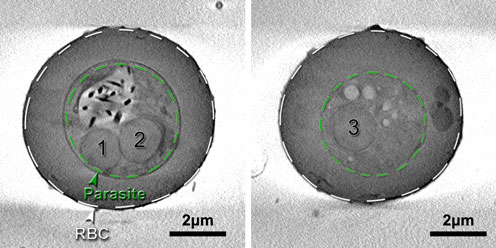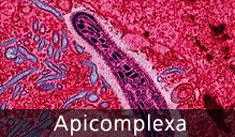An important step towards new malaria medicine
An international research team, led by Sergey Kapishnikov and Jens Als-Nielsen from the X-ray and Neutron Science section at the Niels Bohr Institute at the University of Copenhagen, has developed new techniques in analyzing malaria infected red blood cells, an important step towards finding more effective medicine. This apicomplexan is the biggest killer in the world.

On Fig 1. you see two virtual slices. On the left side it is through the parasite. The digestive vacuole is light gray and the hemozoin crystals are black. In addition you see two nuclei. To the right you see a slice behind the vacuole with a third nucleus. The number of nuclei can be used to calculate when the cell was infected.
The parasite has a complicated life cycle, and during most of the time, the parasite is inside a cell, making it very difficult for the immune system to respond.
Dr Kapishnikov’s group used advanced technologies to produce virtual slices of entire cells without damaging them, and examined them with soft and hard x-rays. In particular, they focused on the concentrations of iron, sulfur and potassium, in order to find the concentrations of iron in hemoglobin and in the hemozoin crystals found inside the parasites. They also found that the potassium concentration in infected cells was seven times lower than in pristine cells, but that the overall concentration was the same, suggesting that the potassium was absorbed by the parasite.
The parasite digests hemoglobin, using the protein as a nutrient. Heme molecules are released during the degradation of hemoglobin. Heme is poisonous to the parasite, so it is immediately stored in pairs inside the digestive vacuole as hemozoin crystals. Now they are harmless, so an obvious goal to develop new cures against malaria could be to prevent this hemozoin formation, so that the heme’s negative effects would remain.
An important step has been taken towards developing new cures against malaria.
- Read the article at "Scientific Reports" >>
 Sergey Kapishnikov, Postdoc at X-ray and Neutron Science, Niels Bohr Institute, University of Copenhagen, Phone: +45 35 33 43 55, Email: Sergey.Kapishnikov@nbi.ku.dk
Sergey Kapishnikov, Postdoc at X-ray and Neutron Science, Niels Bohr Institute, University of Copenhagen, Phone: +45 35 33 43 55, Email: Sergey.Kapishnikov@nbi.ku.dk
See also:
Contact
 Sergey Kapishnikov, Postdoc
Sergey Kapishnikov, Postdoc
Xray and Neutron Science
Universitetsparken 5, 2100 København Ø, HCØ, Building: D308
Email: Sergey.Kapishnikov@nbi.ku.dk
Phone: +45 35 33 43 55
 Jens Als-Nielsen, Professor emeritus
Jens Als-Nielsen, Professor emeritus
Universitetsparken 5, 2100 København Ø, HCØ, Building: D320
Email: als@nbi.ku.dk
Phone: +45 28 75 04 25
About the research
|


